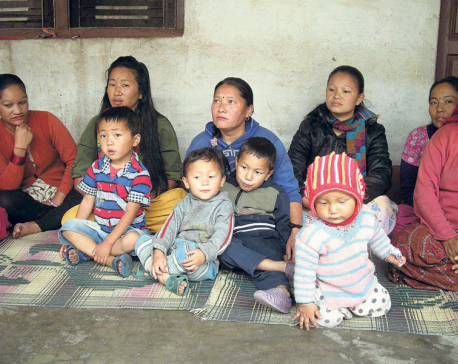
OR


Dev Raj Acharya
The author is a lecturer on Education and International Development at School of Education, Aberystwyth University, Walesnews@myrepublica.com
More from Author
Adolescents’ sexual health knowledge and understanding is influenced by a variety of factors. Sex education should include all these factors
Many Nepali adolescents engage in unsafe sexual practices due to lack of proper information about sexual health and poor accessibility of sexual health services. United Nations Program on HIV/AIDS (UNAIDS) estimates 32,000 adults and children are living with HIV, with a 0.2 percent HIV prevalence rate among adult aged 15-49 in Nepal. A study shows that 48 percent of adolescents aged 15-19 have unmet needs for family planning and 35 percent of female adolescents dropped out of school due to early marriage. Abortions among adolescent girls are also on the rise. There is an improvement in general awareness among adolescents but comprehensive knowledge of sexual health and Sexual and Reproductive Health (SRH) service use is very low among them.
World Health Organization (WHO) defines sexual health as a state of physical, emotional, mental and social well-being in relation to sexuality. It is not merely the absence of disease, dysfunction or infirmity. In 2015, the Sustainable Development Goals (SDG, 2030) were launched to address the incomplete agenda of some of Millennium Development Goals (MDGs, 2015). Goal 3 (good health and well-being), 4 (quality education), 5 (gender equality), and 10 (reduced inequalities) are directly related with SRH. This ensures the universal access to sexual and reproductive health care services, including services for family planning, information and education, and the integration of reproductive health services into national strategies and programs.
Sex education in Nepal
In Nepal, school students are taught sexual and reproductive health (SRH) through sex education curricula in secondary level. It covers basic reproductive health facts concerning safe motherhood, family planning, reproductive physiology, STIs, HIV and AIDS, infertility, adolescent health, health problems of post-menopausal women and reproductive rights. However, little is known as to what extent these contents are practically covered in the classrooms to address the issues of adolescents’ sexual health concern. Thus, an experimental study, referred to as randomised trial, was conducted by this author to observe the effectiveness of delivering sexual health information to the young people in Nepal’s secondary schools. The study found that properly developed sex education session led by the health facilitators from external organisations (Primary Health Centres (PHCs) had a significant impact in the improvement of quality knowledge and understanding of sexual health for the adolescent compared to the conventional teacher-led sex education program.
The study was effective to increase adolescents’ sexual health knowledge because of three main reasons. First, it identified and trained the health facilitators who had an interest in sex education delivery and classroom management. The training provided them a sense of confidence and ownership of the intervention. They developed professional relationships with students to support the teaching of sex education. Second, the study used a participatory learning approach to provide sex education in the classroom. The health facilitators adopted an informal approach and made more use of participatory classroom teaching techniques. These included games and small group work, discussions, brainstorms, role-play and demonstrating how to use condoms. These approaches are used in describing facts about sex and sexuality, identifying adolescents’ sexual health problems and promoting their active participation. This kind of approach is useful in tapping into the unique perspectives of the respondents’ ideas on realistic solutions and has significantly more impact on pre-marital sexual behaviour. Third, the health facilitators followed the international guidelines on sexuality education and delivered 16 planned classroom sessions (a minimum of twelve classroom sessions are recommended), each session lasting for 45 minutes. The sex education sessions were focused in a logical sequence in order to match the objectives of the experimental study and were scheduled with the Health, Population and Environment (HPE) subjects in accordance with the usual school practice for the provision of sex education.
Making it inclusive
Adolescents’ sexual health knowledge and understanding is influenced by a variety of inter-related factors, such as parental influence, gender roles, language and culture, modernisation of the society, myths about sex and sexuality, peer pressure, media and communication, family support and involvement of external experts in school. Thus, sex education should include different partners who have various roles. Adolescents require sexual health information, advice and access to sexual health services. Health professionals should be aware that these services are delivered in a confidential manner. Health professionals who have worked in schools and have developed a good relationship with the teachers and students are mostly liked by schools.
The study suggests that the collaboration and participation between schools and external organisations, such as health authorities, District Education Office (DEO) and community groups is an important aspect of enhancing sexual health knowledge and understanding of adolescents. Therefore, there is a need for participatory structured teaching programs to improve sexual and reproductive health awareness, knowledge and understanding among school students.
Cultural awareness and flexibility into programs are keys to successive aspect of any future school-based sex education intervention in Nepal.
The author is a lecturer on Education and International Development at School of
Education, Aberystwyth University, Wales
dra1@aber.ac.uk
You May Like This

Walkathon to draw attention towards rural children's plight
KATHMANDU, June 26: The Fourth Walkathon will be organized coming Saturday in Kathmandu, to symbolically draw the attention of concerned... Read More...

Rights of every student to quality education secured: Education Minister Shrestha
KATHMANDU, June 14: Deputy Prime Minister and Education Minister, Gopalman Shrestha has said that the right of every student of... Read More...

Children of inmate mothers deprived of education
KHOTANG, Sept 13: Instead of going to school, five-year-old Mausam Rai of Mauwabote-6 in Khotang district has been spending life in... Read More...







Just In
- NRB to provide collateral-free loans to foreign employment seekers
- NEB to publish Grade 12 results next week
- Body handover begins; Relatives remain dissatisfied with insurance, compensation amount
- NC defers its plan to join Koshi govt
- NRB to review microfinance loan interest rate
- 134 dead in floods and landslides since onset of monsoon this year
- Mahakali Irrigation Project sees only 22 percent physical progress in 18 years
- Singapore now holds world's most powerful passport; Nepal stays at 98th











Leave A Comment